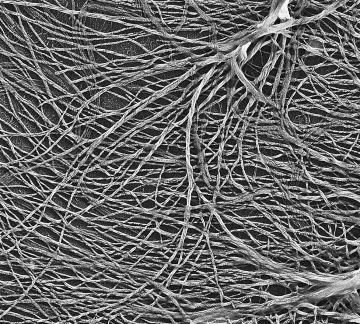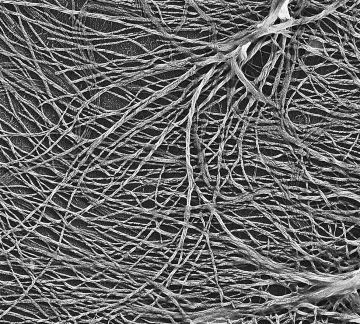Salty, old and, perhaps, a sign of early life
Exploring salt deposits, researchers unearthed the planet's oldest-known, complete molecules thought to have been made by living things.
It’s hard to believe today, but millions of years ago the dusty New Mexico desert was covered by a shimmering ocean. That water evaporated long ago. But it left behind huge deposits of salt. Some of them contain tiny pockets of trapped ancient ocean water. This water serves as super salty time capsules from an era before dinosaurs walked the Earth.
Now, a team of scientists has found the oldest-known biological molecules inside some of those briny salt-water pockets. The team analyzed samples of salt mined deep underground in southeastern New Mexico. They found molecules of cellulose. It’s the tough, fiber-like molecule that makes up plant cell walls. Algae and some bacteria also make cellulose. Because the molecule is made by living organisms, its presence in the salt is evidence that some kind of ancient organism had been around to make it.
 |
|
Scientists found this ancient mat of tiny, threadlike cellulose fibers in 253-million-year-old salt deposits deep below the New Mexican desert. Each of the cellulose fibers, shown here through a microscope, measures between 5 and 16 nanometers (a human hair is about 80,000 nanometers wide).
|
| Jack D. Griffith/University of North Carolina in Chapel Hill |
To identify the cellulose molecules, the scientists removed material from inside the salt-water pockets. They placed it in a hot bath containing sodium hydroxide and sodium borohydride. This harsh solution dissolves all known biological materials. Except cellulose. The material didn’t dissolve what was in the salt. That tells the scientists that the material in the salt deposits most likely was cellulose.
As an additional step, the researchers also mixed the material with a cellulose-digesting enzyme. This time, the material quickly dissolved. Taken together, these results give strong support for the idea that the salt-water pockets contained cellulose.
The research team used radioactive dating to figure out how old the salt crystals — and the cellulose inside of them — were. It appears they formed more than 250 million years ago. In all that time, the crystals have changed little.
These data tell the researchers that ancient salt deposits like these might be ideal for preserving ancient molecules that serve as signs of life. A challenge to researchers looking for evidence of long-extinct living things is that the molecules that made up their bodies usually had broken down already due to sunlight, wind, water or other living things that digested them.
But buried deep below Earth’s surface, the encased cellulose molecules in the salt-water pockets were protected from the sun’s harmful ultraviolet radiation and other harsh conditions. Such conditions might be ideal places to look for signs of long-gone life — both on Earth and on other planets.
Scientists in a field called astrobiology are especially interested in these old cellulose molecules. Astrobiology is the study of life in the universe. Many scientists in this field are hunting ways to search for remains of life on other planets. They’re also looking to answer questions about life in space: Does it exist now. Or did it ever exist in the past?
It’s a good question, but one that’s hard to answer. After all, where would you start looking on Mars if you wanted to look for signs of life? As it turns out, both Mars and Jupiter’s moon Europa once had oceans — just like the New Mexico desert. Do they have similar salt deposits? No one knows. But if planets and moons do, they might give scientists a good starting place to look for signs of past life.
Power Words
From The American Heritage® Student Science Dictionary, The American Heritage® Children’s Science Dictionary, and other sources.
brine or briny Water containing large amounts of salt.
cellulose A carbohydrate that is the main component of the cell walls of plants. It is insoluble in water and is used to make paper, cellophane, textiles, explosives and other products.
digestion The process by which food is broken down into simple chemical compounds that can be absorbed and used in the body.
enzyme Any of the proteins produced in living cells that act as catalysts in the metabolic processes of an organism.
Europa The sixth moon of the planet Jupiter.
Jupiter The planet that is fifth in distance from the sun. Jupiter is the largest planet in the solar system and has the shortest day, lasting less than 10 hours.
Mars The planet that is fourth in distance from the sun. Mars is the third smallest planet in the solar system and is similar to Earth.
radioactive dating A technique for measuring the age of a material based on the spontaneous breakdown of a radioactive nucleus into a lighter nucleus.
ultraviolet radiation Electromagnetic radiation that has wavelengths shorter than those of visible light but longer than those of X-rays. Ultraviolet light is given off by the sun but is invisible.
 |
Copyright © 2002, 2003 Houghton-Mifflin Company. All rights reserved. Used with permission.
Going Deeper:
Perkins, Sid. 2008. Salty Old Cellulose: Tiny Fibers Found in Ancient Halite Deposits. Science News 173(April 5):213. Available at http://www.sciencenews.org/articles/20080405/fob5.asp .
Cowen, Ron. 2007. A Crack at Llife. Science News 171(March 10):158. Available at http://www.sciencenews.org/articles/20070310/note12.asp .
Pegg, J.L. 2007. An Earthlike Planet. Science News for Kids (May 2). Available at http://www.sciencenewsforkids.org/articles/20070502/Note2.asp .
Travis, John. 1999. Prehistoric Bacteria Revived from Buried Salt. Science News 155(June 12):373. Available at http://www.sciencenews.org/pages/sn_arc99/6_12_99/fob3.htm .







